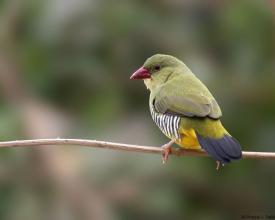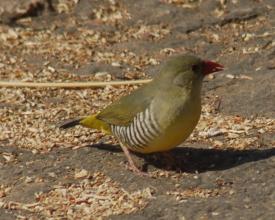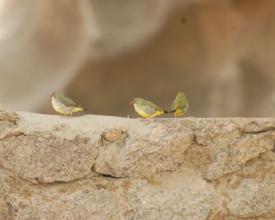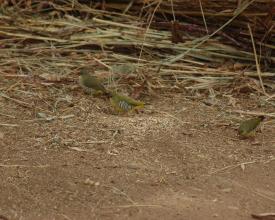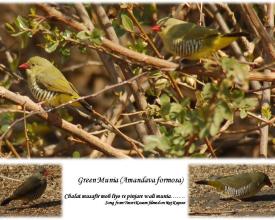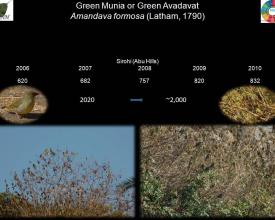
Nature Tourism at Abu Hills (Rajasthan, India): Conservation and Livelihood
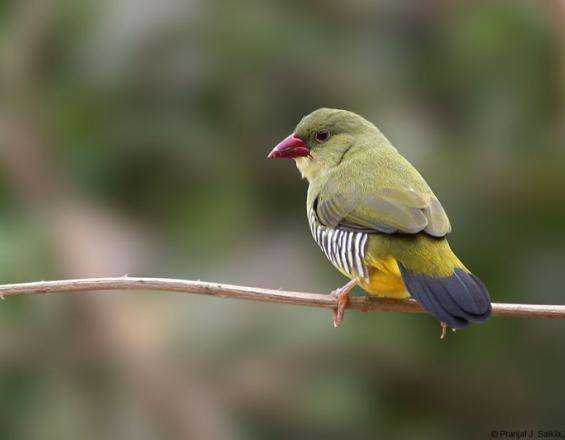
In line with the three pillars of sustainability, we developed globally applicable site-specific socio-ecological-economy models. One of our four models is called Abu Model. The idea behind this model was the protection of the Green Avadavat or Green Munia, categorized ‘Vulnerable’ in IUCN Red List.
Taking advantage of the interdependency of tourism and the environment, we focused on the flagship species of Abu Hills, consisting of the Green Munia and several other fauna and flora species. A group of local youth closely associated with nature was identified, including bird trappers and poachers. Their traditional local knowledge was valuable to modern scientific knowledge and empowered them. Thus, the nature related skills of the local youth were linked with the livelihood options. This approach fostered the conservation actions towards the protection of habitats and target species.
Context
Challenges addressed
- Conservation Issue of the Green Munia: The Green Munia is a globally threatened endemic species of India. But Abu Hill in Rajasthan still holds a significant population. It was categorized as Vulnerable in the early 1990s. It is listed in Schedule IV of the Wildlife (Protection) Act, 1972 of India, and Appendix II of the Convention on International Trade in Endangered Species (CITES).
- Social Issue of the local community: Limited income generation sources for the local people. A lack of respect for the traditional and customary rules in the modern and intellectual world created a gap between the communities.
- Tourism issues of Abu Hill: Tourism in Abu Hill was limited to the historical and religious sectors. Moreover, tribal youth were hardly involved in the tourism field. Nature tourism was neglected in Abu Hill.
Location
Process
Summary of the process
Using the eco-cultural ethos, the protection of the habitats with the community conservation actions were initiated by the authors which involved identifying the interested youth, capacity building and their engagement in the nature guiding with special focus on nature praising, birding, herping, etc. The local action with global vision of fulfilling the targets of SDGs through empowering the local youth for their livelihood and transforming the poachers/ trappers into conservation groups for protecting a globally threatened species and/or habitats.
Building Blocks
Strategic Planning
The most important feature of the intervention was the set-target and well defined objectives. Based on the principle of win-win at the end of all the sides, the strategies were planned and executed. Another important feature included the flexible and customized approach of the strategy.
Enabling factors
Micro and macro planning with flexibility.
Lesson learned
Even though the flexibility was kept in the strategic plans but the mandatory actions needed to be executed within time-frame for future analysis.
Community Ownership
Due respect was given to the indigenous customs and traditions of the target (deprived) section of the community. This action transformed the local community to take the ownership which fostered community participation resulting into the success of the interventions.
Enabling factors
The target community felt closeness with the interventions.
Lesson learned
The community participates only through the level of the ownership which needs involvement of the eco-traditions and customs followed by the community.
Attitude of the Stakeholders
The energetic zeal and passion of the mentors and the local youth at every phase, from step one of planning to the last one of execution, could be treated as important feature in success of the interventions. The stakeholders learned about the scope of other attributes of tourism at Abu Hills. This triggered the interest of stakeholders to get involved with the tourism sector in anyway. Thus, nature tourism was popularized.
Enabling factors
The motivation and inspirational leadership of the executing persons/ agencies.
Lesson learned
The role and responsibility undertaken by the implementing agency or the people need to have the positive attitude with strong commitment.
Replication
Another important aspect of the intervention was the ability of replication and site-specificity. These features made the interventions important for all such areas where there is a need of conservation of certain habitats and species.
Enabling factors
The models are scalable and replicable.
Lesson learned
The fact that the model is site-specific means there's no competition when replicated.
Site selection
The species in focus was a demand for the conservationists, ecologists, biologists, etc. Thus, the importance of the target species and the habitat at the global level gave the interventions a global impact. The threatened species is a part of the global conservation action, therefore, took immediate attention.
Enabling factors
The selection of the sites for nature-tourism was based on the type of species and habitat of global importance.
Lesson learned
The site selected for the nature-tourism purpose plays a vital role. The site with the species and habitat of global relevance attract universal sectors.
Impacts
- Conservation of the species along with protection of their habitats. The individual numbers of the bird species at ten monitoring sites accounted for below four hundred at the time of interventions in 2004 which increased to over 2,000 by the end of 2020. Presently (the year 2022), it was claimed by the competent authority that the actual number might be above 6,000 on Abu Hills with the higher frequency of visual encounters.
- Options for the local income generation increased through Nature-Tourism. It gave a sustainable opportunity for the local people. For example, the income of a local guy was $1.5 per day in 2007 increased to ten folds when they started earning $10 per hour through nature tourism.
Beneficiaries
- Government agencies: Forest and Tourism sectors
- Non-government agencies (focussing conservation action)
- Local communities
- Academic sector (new research topics)
Sustainable Development Goals
Story
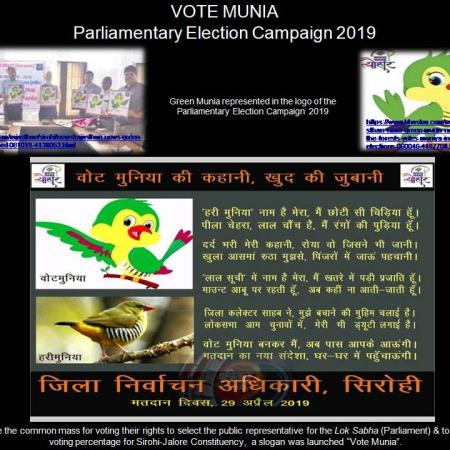
A red beaked little beauty of different green shades from dull green on dorsal to yellow belly and zebra lining flanks is the popular member of “Finch” family among global community. The vernacular name of this little beauty “MUNIA” is a representation of a baby. The beauty is described in the song “Chalat musafir moh liya re, pinjare wali munia” (the beauty of the cage bird attracts every passing by visitors) from the Hindi Movie “Teesri Kasam”.
Post-2000s Distribution: On comparing the birders observations from the pre-2000 and the post-2000 period, the reporting indicated that the commonness of the presence of Green Munia in the defined central belt of central India has been lost.
Through the traditional conservation practices, the community manages its natural heritage which can be used for site-specific conservation programs and policies to achieve the global targets of SDGs through local actions.
The Indian traditions and customs describe the symbiotic relationship of human and nature through its eco-cultural ethos of ‘Prakruti Purush’ (nature and human). Using the eco-cultural ethos, the protection of the habitats with community conservation actions were initiated by our team, which involved identifying the interested youth, capacity building and their engagement in the nature guiding with special focus on birding, etc. Through the local trained team, the local human population settled on the edges of the forests (potential sites for Green Munia), encouraged to be involved in safeguarding the feeding grounds. The people realized the importance of the species and stepped ahead with the local conservation actions. The regular monitoring program was introduced in 2004-05 at the potential sites which observed, that the number of individuals accounted below four hundred in the first decade of 2000s, was five-folds with extension of the specific sites in the end of the year 2019.
The impact observed through such interventions gave an opportunity for every sector a win. Through local participation and Nature-Tourism, the population of bird species increased from few hundreds (<400 in 2004) to thousands (>2,000 in 2020) with ten times increase in the income of the reformed trappers (from $1.5 per day to $10 per hour) based on visitors movement.

